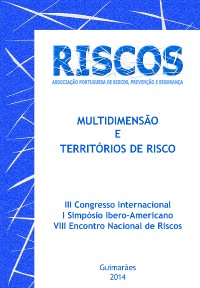Please use this identifier to cite or link to this item:
https://hdl.handle.net/10316.2/34812| DC Field | Value | Language |
|---|---|---|
| dc.contributor.author | Figueiredo, Tomás de | |
| dc.contributor.author | Fonseca, Felícia | |
| dc.contributor.author | Pinheiro, Helena | |
| dc.date.accessioned | 2014-12-11T17:20:25Z | |
| dc.date.accessioned | 2020-09-09T18:06:20Z | - |
| dc.date.available | 2014-12-11T17:20:25Z | |
| dc.date.available | 2020-09-09T18:06:20Z | - |
| dc.date.issued | 2014 | - |
| dc.identifier.isbn | 978-989-96253-3-4 (PDF) | |
| dc.identifier.uri | https://hdl.handle.net/10316.2/34812 | - |
| dc.description.abstract | Continental Portugal endures an increase in desertification susceptibility, a process accelerated by soil degradation and wildfires. This work aims at discussing outcomes of a research, at territorial scale, on fire hazard relations with soil degradation and desertification susceptibility in NE Portugal, specifically in Bragança District, based on GIS desertification susceptibility fire hazard, land cover and soil degradation maps. High and very high fire hazard prevails in near 2/3 of the territory and around 3/4 are susceptible to desertification, falling in the semi-arid and dry sub-humid climatic domains; about 20% of the former fall in the semi-arid. In around 3/4 of the area with high/very high fire hazard soils depict severe or worse degradation status, and in around 40% they are covered by scrublands, where fuel stock is high and social control is negligible. This negative picture asks for measures towards effective soil protection, a key resource for territorial sustainability. | eng |
| dc.language.iso | eng | - |
| dc.publisher | RISCOS - Associação Portuguesa de Riscos, Prevenção e Segurança | por |
| dc.publisher | Imprensa da Universidade de Coimbra | por |
| dc.relation.ispartof | http://hdl.handle.net/10316.2/34789 | por |
| dc.rights | open access | - |
| dc.subject | Continental Portugal endures an increase in desertification susceptibility, a process accelerated by soil degradation and wildfires. This work aims at discussing outcomes of a research, at territorial scale, on fire hazard relations with soil degradation and desertification susceptibility in NE Portugal, specifically in Bragança District, based on GIS desertification susceptibility fire hazard, land cover and soil degradation maps. High and very high fire hazard prevails in near 2/3 of the territory and around 3/4 are susceptible to desertification, falling in the semi-arid and dry sub-humid climatic domains; about 20% of the former fall in the semi-arid. In around 3/4 of the area with high/very high fire hazard soils depict severe or worse degradation status, and in around 40% they are covered by scrublands, where fuel stock is high and social control is negligible. This negative picture asks for measures towards effective soil protection, a key resource for territorial sustainability | eng |
| dc.subject | Continental Portugal endures an increase in desertification susceptibility, a process accelerated by soil degradation and wildfires. This work aims at discussing outcomes of a research, at territorial scale, on fire hazard relations with soil degradation and desertification susceptibility in NE Portugal, specifically in Bragança District, based on GIS desertification susceptibility fire hazard, land cover and soil degradation maps. High and very high fire hazard prevails in near 2/3 of the territory and around 3/4 are susceptible to desertification, falling in the semi-arid and dry sub-humid climatic domains; about 20% of the former fall in the semi-arid. In around 3/4 of the area with high/very high fire hazard soils depict severe or worse degradation status, and in around 40% they are covered by scrublands, where fuel stock is high and social control is negligible. This negative picture asks for measures towards effective soil protection, a key resource for territorial sustainability | eng |
| dc.subject | fire hazard | eng |
| dc.subject | NE Portugal | eng |
| dc.title | Fire hazard and susceptibility to desertification: a terrirorial approach in NE Portugal | por |
| dc.type | bookPart | por |
| uc.publication.firstPage | 117 | - |
| uc.publication.lastPage | 121 | - |
| uc.publication.location | Coimbra | por |
| dc.identifier.doi | 10.14195/978-989-96253-3-4_20 | - |
| uc.publication.section | Capitulo 2 - Geotecnologias aplicadas à análise e gestão de riscos | por |
| uc.publication.digCollection | PB | por |
| uc.publication.orderno | 20 | - |
| uc.publication.area | Ciências Sociais | por |
| uc.publication.bookTitle | Multidimensão e territórios de risco | - |
| uc.publication.manifest | https://dl.uc.pt/json/iiif/10316.2/34812/210391/manifest?manifest=/json/iiif/10316.2/34812/210391/manifest | - |
| uc.publication.thumbnail | https://dl.uc.pt/retrieve/11164556 | - |
| uc.publication.parentItemId | 53875 | - |
| uc.itemId | 70098 | - |
| item.grantfulltext | open | - |
| item.fulltext | With Fulltext | - |
| Appears in Collections: | Multidimensão e territórios de risco | |
Files in This Item:
| File | Description | Size | Format | |
|---|---|---|---|---|
| 20.pdf | 2.99 MB | Adobe PDF |  |
Items in DSpace are protected by copyright, with all rights reserved, unless otherwise indicated.
